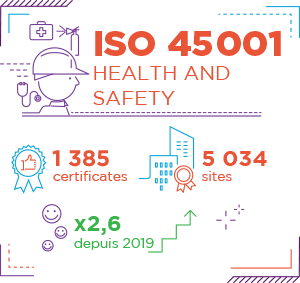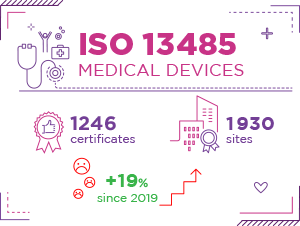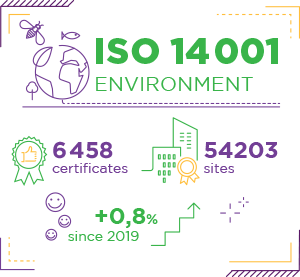The three key trends concerning certified management systems in 2020

As it does every year in the autumn, the International Organization for Standardization (ISO) offers an estimate of the number of active certificates worldwide, country by country and sector by sector, distinguishing between companies that have deployed management systems based on 12 major international standards. At December 31, 2020, it was in the area of occupational health and safety (ISO 45001) that the figures stood out from a year earlier. Including in France. Two other trends are emerging.
The health and safety boom
It’s the star of ISO Survey 2020, the annual census of companies that have deployed their management systems and had them certified: the
ISO 45001 certification
certification, which rewards management systems that comply with the ISO 45001 occupational health and safety (OHS) standard, appeared on the shop fronts of 190,429 companies worldwide on December 31, 2020. That’s five times more than a year earlier. The same phenomenon can be observed in France: 1,385 active certificates at December 31, 2020, compared with 524 a year earlier. This tripling is reflected in the number of sites covered by a certificate (a certificate can cover several sites of the same company): 5,034 by the end of 2020 compared with 1,523 by the end of 2019.
 The explanation is simple: having only appeared in 2018, the ISO 45001 standard is now spreading throughout the economic fabric and companies are starting to adopt it on a massive scale, replacing the occupational health and safety standard that was previously the authority: OHSAS 18001. ” To date, 85% of the French companies we certified to OHSAS 18001, mainly in construction and industry, have switched to ISO 45001. We had roughly the same percentage with just a few weeks to go before the deadline for the transition to the 2015 version of ISO 9001 for quality and 14001 for the environment. “As Béatrice Poirier, AFAQ ISO 45001 Product Manager at AFNOR Certification, pointed out on September 30, 2021, the day on which the last OHSAS 18001 certificates lost their validity.
The explanation is simple: having only appeared in 2018, the ISO 45001 standard is now spreading throughout the economic fabric and companies are starting to adopt it on a massive scale, replacing the occupational health and safety standard that was previously the authority: OHSAS 18001. ” To date, 85% of the French companies we certified to OHSAS 18001, mainly in construction and industry, have switched to ISO 45001. We had roughly the same percentage with just a few weeks to go before the deadline for the transition to the 2015 version of ISO 9001 for quality and 14001 for the environment. “As Béatrice Poirier, AFAQ ISO 45001 Product Manager at AFNOR Certification, pointed out on September 30, 2021, the day on which the last OHSAS 18001 certificates lost their validity.
In 2020, the theme of OHS also had the covid-19 effect: between confinements, barrier gestures and the psychological damage of all-at-a-distance, health has taken pride of place in the world of work, forcing companies to consider it from a more global angle than that of accidentology and musculoskeletal disorders, which are well known in the world of industry. It’s worth noting that ISO 22301 certification, covering business continuity management, has not followed the same path as ISO 45001, even though the year 2020 was a peak in terms of disruptions, and showed that getting organized to cope with them was a matter of survival. Last but not least, appetite for safety in the workplace extends to cybersecurity: ISO/IEC 27001 certifications for information security management are up 11% in France and 22% worldwide.
Quality sectorization
The second major trend in this ISO Survey 2020 vintage is that the race for quality is no longer measured solely in terms of the number of ISO 9001 certificates and the number of sites covered: ISO 22000 (food safety), ISO 13485 (medical devices), ISO/IEC 20000-1 (IT services), but also other standards distinct from the ISO family (and therefore not covered by the study) such as IATF 16949 in the automotive sector, EN 9100 in aeronautics or IRIS TS/22163 in the rail sector.
ISO 22000 (food safety), ISO 13485 (medical devices), ISO/IEC 20000-1 (IT services), but also other standards distinct from the ISO family (and therefore not covered by the study) such as IATF 16949 in the automotive sector, EN 9100 in aeronautics or IRIS TS/22163 in the rail sector.
In France, the number of ISO 13485 certificates active at December 31, 2020 rose by 19%. This growth is mirrored worldwide (over 25,000 certificates covering more than 35,000 sites), and can be explained by a buoyant regulatory context: the entry into force of EU Regulation 2017/745 on medical devices on May 26, 2021. On the strength of a standard revised two years earlier, ISO 22000 was also a great success, with 804 active certificates, 300 more than a year earlier. Also in France, the state-approved Qualiopi standard for continuing training organizations (which must be certified before January 2022 to remain in the regulated market with paritarian funding) has resulted in several thousand certificates being issued, while the overall number of ISO 9001 certificates is stagnating. In this case, France remains in 8th place in a global hit parade led by China.
One certificate for more sites
 The third major trend in the 2020 vintage of ISO Survey is rationalization. One certificate covers more and more sites. In France, for example, the ISO 14001 standard will not lead to more certifications than in 2019 (only 56 more), but to certifications covering three times as many sites (1 certification for 3 sites in 2019, 1 for 9 in 2020). Large groups, which at one time opted for site-by-site certification, are now pooling their certificates and optimizing audits,” explains Vincent Gillet, Deputy Secretary General of AFNOR. Integrated management systems have been promoted for many years. This has the effect of bringing together several themes (quality, safety, environment, grouped under QSE) under a single certification process, as well as integrating the different QMSs that may have existed within the same group. ”
The third major trend in the 2020 vintage of ISO Survey is rationalization. One certificate covers more and more sites. In France, for example, the ISO 14001 standard will not lead to more certifications than in 2019 (only 56 more), but to certifications covering three times as many sites (1 certification for 3 sites in 2019, 1 for 9 in 2020). Large groups, which at one time opted for site-by-site certification, are now pooling their certificates and optimizing audits,” explains Vincent Gillet, Deputy Secretary General of AFNOR. Integrated management systems have been promoted for many years. This has the effect of bringing together several themes (quality, safety, environment, grouped under QSE) under a single certification process, as well as integrating the different QMSs that may have existed within the same group. ”
However, this trend needs to be qualified by the covid effect: if in 2020, not all certifications repeated their growth of a year earlier, it’s also because, quite simply, companies who wanted to apply for theirs (either for an initial audit, or for renewal) didn’t do so, due to health measures that limited the possibility for an auditor to visit the site. This is despite the fact that certifying bodies have taken steps to offer remote formulas.
ISO Survey 2020 results (©Getty Images/NitatTermmee)